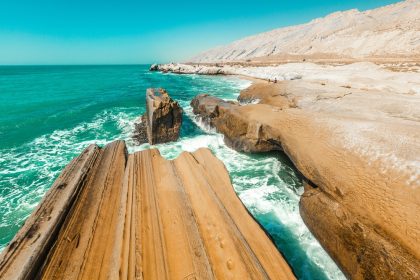Simultaneously with the opening of the archaeological field research base of Shahid Beheshti University, the archaeological excavations started in Cheshme Ali Ray hill with the participation of this university.
Hamidreza Valipour, the head of the archeological excavations team at Cheshme Ali Ray hill, explained this project and said:
Cheshme Ali hill is located in the south of Tehran in the area of the ancient city of Ray and next to a spring from which it got its name. This hill is about seven meters high and is located next to the remains of the wall of the Islamic city of Ray, which is a 15-meter-high rock-like ridge. Currently, Cheshme Ali hill is surrounded by surrounding streets and modern buildings.
He added:
Shahid Beheshti University, through a tripartite memorandum of understanding with the Research Institute of Cultural Heritage and Tourism and the General Directorate of Cultural Heritage of Tehran Province, established the archeology field research base of this university in the building adjacent to the Mill Hill, and a five-year plan for exploring Cheshme Ali Shahr Ray Hill to the General Directorate of Cultural Heritage of the Province Tehran and research institute suggested. This problem-oriented program intends to study the process of cultural development of societies from the Neolithic to the Copper Age and to evaluate some of the hypotheses and theories proposed about the reasons for cultural changes in the central plateau of Iran and the variables affecting this process.
This archaeologist stated:
The aforementioned research program was approved by the Research Council of the Research Institute of Archeology and based on that, the permission to explore this area was issued by the Research Institute of Cultural Heritage and Tourism. These excavations will continue with the material and spiritual support of Shahid Beheshti University and with the presence of the faculty members of the archeology department, members of the excavation committee and with the participation of undergraduate archeology students entering 2019 of this university until the end of November of this year.
In explaining the problem, goals and research program, he said:
According to Schmidt’s archaeological excavations, the sequence of layering from the Neolithic period to the historical and Islamic periods can be seen in this area. During the stratification excavations of 1376, the cultural deposits of three New Neolithic periods, Transitional Copper Stone and Old Copper Stone periods were found, and no archaeological tissue has been identified from the Middle and New Stone Copper periods. The Cheshme Ali layering sequence provided a pattern of change over time from the New Neolithic to the Old Copper Age. In the layers of the Transition Stone Copper Age, several architectural units were identified, which included thermal structures and burial remains. The last prehistoric settlement in this area is the Old Stone Copper Age, which was recognized only by pottery and stone tools.
Head of Cheshme Ali Hill Exploration Board said:
The re-study program of Cheshme Ali materials, especially the pottery obtained from the excavations of Erich Schmidt, which is kept in the universities of Chicago, Pennsylvania, and Harvard, has revealed that during his excavations, Schmidt, in addition to the archaeological deposits obtained from the excavations of 1376, found works related to the Middle Stone Copper Age and It has also explored the new.
Valipour noted:
By studying the pottery of the above collection, a large number of pottery of the middle and new phases of stone copper were revealed. This problem clearly shows that when Schmidt explored this area in the 1930s, there were deposits related to the above periods; But during the 60 years since then, the upper layers of this area have been destroyed, so that in the excavations of 1376, no sign of them was seen in the hill. The same issue applies to many other areas of the Tehran plain that have been exposed to destruction due to the expansion of urban construction or agricultural and industrial activities.
He stated that the Transition Stone Copper Period, which is referred to by various titles such as Cheshme Ali Period, Old Plateau Period or Silk II Culture, is very important in the prehistoric archeology of the Central Plateau of Iran, he stated:
Some archaeologists, including Dr. Yusuf Majidzadeh, believe that the settlements of this period in the central plateau of Iran were abandoned by the influx of people from the western regions, and then the Silk III culture provides evidence of the decay of previous cultures and the beginning of a new culture in the central plateau of Iran. Girshman’s excavations in Silk and the excavations of Tehran University’s archeology department in the Qazvin plain in slums and cemeteries and other findings obtained from other areas of the Central Plateau of Iran, such as Pardis Varamin hill, have challenged these theories.
Head of Cheshme Ali Hill Exploration Board said:
The exploration of Cheshme Ali on the remains of the period of transitional copper stone and old copper stone (called Silk II and III) can provide us with evidence about the issue of discontinuity, discontinuity or continuity and continuity of the cultures of these two phases of stone copper. Therefore, in a five-year program, it is planned to investigate and analyze this issue with regard to stylistic studies on architectural remains, pottery, burials and other findings by horizontal exploration of the cultural deposits of the two mentioned periods. In addition, in order to understand the processes of cultural change from the Neolithic period to the Copper Age, we intend to investigate and study the process of cultural development of societies and cultural continuity or discontinuity from the Neolithic to the Copper Age in the level of today’s plain and at the bottom of the hill by creating trenches.
This archaeologist noted:
Therefore, we intend to focus the archaeological excavations of Shahid Beheshti University on this area for several years, so that the cultural materials obtained from it can be used in the analysis and interpretation of the cultural development process of the prehistoric societies living in this area in various biological, social, economic and livelihood dimensions. be taken In addition, it is intended to evaluate the previous assumptions and theories about the diversity and cultural change of Dasht Ray communities in the desired periods.
He added:
Based on this, by comparing the cultural materials obtained from Schmidt’s excavations in this area and the archaeological comparison of the data and information obtained from the field researches in the Central Plateau of Iran, we intend to evaluate the aforementioned theories about the issue of diffusion, migration or invasion of western Iranian societies to the Central Plateau. In the mentioned courses, let’s follow up the endogenous cultural dynamics in this region.
RCO NEWS














